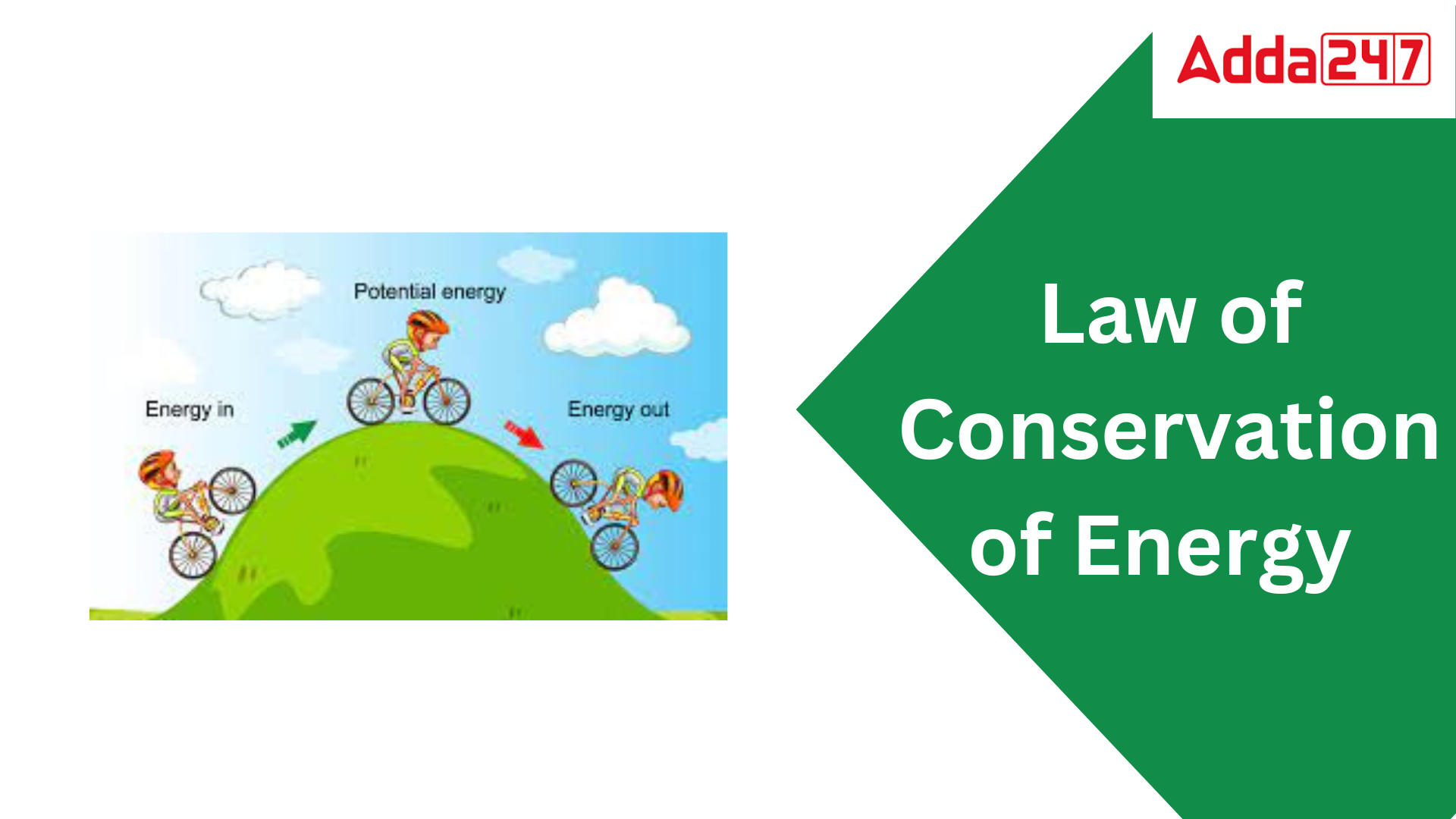Law of conservation of energy: The evolution of living forms on Earth necessitates the use of energy. It is defined as the ability to conduct work in physics. We know that energy occurs in nature in various forms. You’ve learned about numerous types of energy, such as heat, electricity, chemicals, and nuclear power. We will study the rules and concepts that control energy in this essay. This is known as the law of energy conservation.
Law of conservation of energy Definition
One of the most fundamental rules of physics is the law of conservation of energy. It is stated that energy cannot be generated or destroyed but simply transferred from one form to another. This implies that the total amount of energy in the universe remains constant. There are several examples of the law of energy conservation in everyday life. When you throw a ball, for example, the potential energy of the ball at the peak of the throw is turned into kinetic energy as the ball falls. The kinetic energy of the ball is transformed into heat and sound when it strikes the ground. An automobile engine is another example of the rule of conservation of energy. The chemical energy in petrol is turned into heat energy, which is then converted into kinetic energy in the form of the car’s motion. The law of conservation of energy is a fundamental principle in physics. It assists us in comprehending how the cosmos operates and how energy may be transformed from one form to another.
What is the Law of Conservation of Energy? Class 9
According to the rule of conservation of energy, energy cannot be created or destroyed. It can, however, be converted from one form to another. When all forms of energy are considered, the overall energy of an isolated system remains constant. The law of energy conservation applies to all kinds of energy. In summary, the law of energy conservation asserts that “The total energy of a closed system, that is, a system that is separated from its surroundings, is preserved.”
So, in an isolated system like the universe, if there is a loss of energy in one area of it, there must be an equivalent quantity of energy gained in another section of the universe. Although this principle cannot be proven, there is no known case of a violation of the principle of energy conservation.
The amount of energy in any system is calculated by the following equation: UT = Ui + W + Q
- The total energy of a system is represented by UT.
- The initial energy of a system is denoted by Ui.
- Q is the amount of heat added or removed from the system.
- W denotes the work done by or on the system.
- The equation U = W + Q is used to calculate the change in the system’s internal energy.
Law of Conservation of Energy Formula Derivation
Consider the case of an object that has fallen to the ground. Assume that the potential energy at the earth’s surface is zero.
Consider location A, which is at a height ‘H’ above the ground; the velocity of the item is zero, hence potential energy is greatest at this point.
E = mgH ———- (1)
When an object falls, its potential energy decreases and its kinetic energy increases.
The object falls freely due to gravity and is at a height “X” above the ground at point B. It will now have both kinetic and potential energy.
E = K.E + P.E
P.E = mgX ——— (2)
According to the third equation of motion,
v2 = 2g (H – X)
12 mv2 = 12 m. 2g (H – X)
K.E = 12 m. 2g (H – X)
K.E = mg (H – X)——- (3)
Using equations (1), (2), and (3)
E = K.E + P.E
E = mg (H – X) + mgX
E = mg (H – X + X)
E = mgH
Similarly, if we extract energy at point C, which is at the bottom, we get mgH. As the object descends, its potential energy is turned into kinetic energy. There must be a point at which kinetic energy equals potential energy of the falling object. Assume this position is ‘x’ metres above the ground. At this point,
K.E = P.E
P.E = K.E = E/2 ——- (4)
The body is at X feet above the ground.
P.E = mgX ——— (5)
Using equations (4) and (5), we obtain:
mgX = mgH/2
X = H/2
So H/2 is the new height.
How does the law of energy conservation apply to thermodynamics?
The law of energy conservation is also related to thermodynamics, the study of the relationship between heat and other kinds of energy. The law of conservation of energy is known as the first law of thermodynamics in thermodynamics. According to the first law of thermodynamics, the total energy of an isolated system is constant. This means that in an isolated system, energy can be changed from one form to another, but the total amount of energy remains constant.
Many thermodynamic phenomena, such as heat transmission and work done by a system, can be explained using the basic law of thermodynamics. When you heat a pot of water, for example, the heat energy you supply to the water is turned into the internal energy of the water molecules. Because of the increase in internal energy, the water molecules travel faster, causing the water to boil.The first law of thermodynamics is a fundamental law of nature that has been tested and confirmed numerous times. It is a strong tool for understanding and predicting the behaviour of energy-related systems.The significance of the energy conservation legislation
One of the most essential rules in physics is the law of conservation of energy. It has various applications in our daily lives, from how our automobiles work to how the world evolves. The law of energy conservation reminds us that energy is a valuable resource that we should not take for granted.
Importance of Law of conservation of energy
Here are some of the importance of the energy conservation law:
- It aids our understanding of how the cosmos operates.
- It can be used to explain various natural phenomena, including as object motion, heat transfer, and machine operation.
- It can be used to create and enhance energy-saving devices and systems.
- It has the potential to help us conserve energy and minimise our reliance on fossil fuels.
- The concept of conservation of energy is a powerful tool for understanding and shaping the world around us. It serves as a reminder that energy is a finite resource that should not be taken for granted.
Example of Law of conservation of energy
The majority of inventions in Physics are based on the fact that energy is conserved when it is moved from one form to another. A number of electrical and mechanical devices rely entirely on the concept of energy conservation. Here are a few instances.
- In a torch, the chemical energy of the batteries is transformed into electrical energy, which is then converted into light and heat energy.
- Waterfalls from a height on the turbines in hydroelectric power facilities. This, in turn, rotates the turbines and generates power. As a result, the potential energy of water is turned into kinetic energy of the turbine, which is then translated into electrical energy.
- Electrical energy is transferred to sound energy in a loudspeaker.
- Sound energy is transformed to electrical energy in a microphone.
- Mechanical energy is converted to electrical energy in a generator.
- When fuels are burned, chemical energy is transformed into heat and light energy.
- When food is broken down in the body, the chemical energy is transformed to thermal energy and used to keep the body warm.
Law of conservation of energy in Hindi
ऊर्जा संरक्षण का नियम: पृथ्वी पर जीवित जीवों के विकास के लिए ऊर्जा के उपयोग की आवश्यकता होती है। इसे भौतिकी में कार्य करने की क्षमता के रूप में परिभाषित किया गया है। हम जानते हैं कि प्रकृति में ऊर्जा विभिन्न रूपों में पाई जाती है। आपने अनेक प्रकार की ऊर्जा, जैसे ऊष्मा, बिजली, रसायन और परमाणु ऊर्जा के बारे में सीखा है। हम इस निबंध में ऊर्जा को नियंत्रित करने वाले नियमों और अवधारणाओं का अध्ययन करेंगे। इसे ऊर्जा संरक्षण के नियम के रूप में जाना जाता है।
ऊर्जा संरक्षण का नियम परिभाषा
भौतिकी के सबसे बुनियादी नियमों में से एक ऊर्जा संरक्षण का नियम है। ऐसा कहा जाता है कि ऊर्जा को उत्पन्न या नष्ट नहीं किया जा सकता है बल्कि इसे एक रूप से दूसरे रूप में स्थानांतरित किया जा सकता है। इसका तात्पर्य यह है कि ब्रह्मांड में ऊर्जा की कुल मात्रा स्थिर रहती है। रोजमर्रा की जिंदगी में ऊर्जा संरक्षण के नियम के कई उदाहरण हैं। उदाहरण के लिए, जब आप एक गेंद फेंकते हैं, तो थ्रो के चरम पर गेंद की स्थितिज ऊर्जा गेंद के गिरते ही गतिज ऊर्जा में बदल जाती है। जब गेंद जमीन से टकराती है तो उसकी गतिज ऊर्जा ऊष्मा और ध्वनि में बदल जाती है। एक ऑटोमोबाइल इंजन ऊर्जा संरक्षण के नियम का एक और उदाहरण है। पेट्रोल में रासायनिक ऊर्जा को ऊष्मा ऊर्जा में बदल दिया जाता है, जिसे बाद में कार की गति के रूप में गतिज ऊर्जा में बदल दिया जाता है। ऊर्जा संरक्षण का नियम भौतिकी का एक मूलभूत सिद्धांत है। यह हमें यह समझने में सहायता करता है कि ब्रह्मांड कैसे संचालित होता है और ऊर्जा को एक रूप से दूसरे रूप में कैसे परिवर्तित किया जा सकता है।
ऊर्जा संरक्षण का नियम क्या है? कक्षा 9
ऊर्जा संरक्षण के नियम के अनुसार ऊर्जा को न तो बनाया जा सकता है और न ही नष्ट किया जा सकता है। हालाँकि, इसे एक रूप से दूसरे रूप में परिवर्तित किया जा सकता है। जब ऊर्जा के सभी रूपों पर विचार किया जाता है, तो एक पृथक प्रणाली की समग्र ऊर्जा स्थिर रहती है। ऊर्जा संरक्षण का नियम सभी प्रकार की ऊर्जा पर लागू होता है। संक्षेप में, ऊर्जा संरक्षण का नियम इस बात पर जोर देता है कि “एक बंद प्रणाली की कुल ऊर्जा, यानी एक प्रणाली जो अपने परिवेश से अलग हो जाती है, संरक्षित रहती है।”
इसलिए, ब्रह्मांड जैसी एक पृथक प्रणाली में, यदि इसके एक क्षेत्र में ऊर्जा की हानि होती है, तो ब्रह्मांड के दूसरे खंड में उतनी ही मात्रा में ऊर्जा प्राप्त होनी चाहिए। हालाँकि इस सिद्धांत को सिद्ध नहीं किया जा सकता है, फिर भी ऊर्जा संरक्षण के सिद्धांत के उल्लंघन का कोई ज्ञात मामला नहीं है।
किसी भी प्रणाली में ऊर्जा की मात्रा की गणना निम्नलिखित समीकरण द्वारा की जाती है: UT = Ui + W + Q
किसी सिस्टम की कुल ऊर्जा को UT द्वारा दर्शाया जाता है।
किसी सिस्टम की प्रारंभिक ऊर्जा को Ui द्वारा दर्शाया जाता है।
Q सिस्टम में जोड़ी गई या निकाली गई ऊष्मा की मात्रा है।
W सिस्टम द्वारा या उस पर किए गए कार्य को दर्शाता है।
सिस्टम की आंतरिक ऊर्जा में परिवर्तन की गणना करने के लिए समीकरण U = W + Q का उपयोग किया जाता है।









 NEET UG 2025 Counselling Dates OUT! Chec...
NEET UG 2025 Counselling Dates OUT! Chec...
 Dr MGR Medical University Results 2025 R...
Dr MGR Medical University Results 2025 R...
 GSEB HSC Science Supply Result 2025 Down...
GSEB HSC Science Supply Result 2025 Down...









